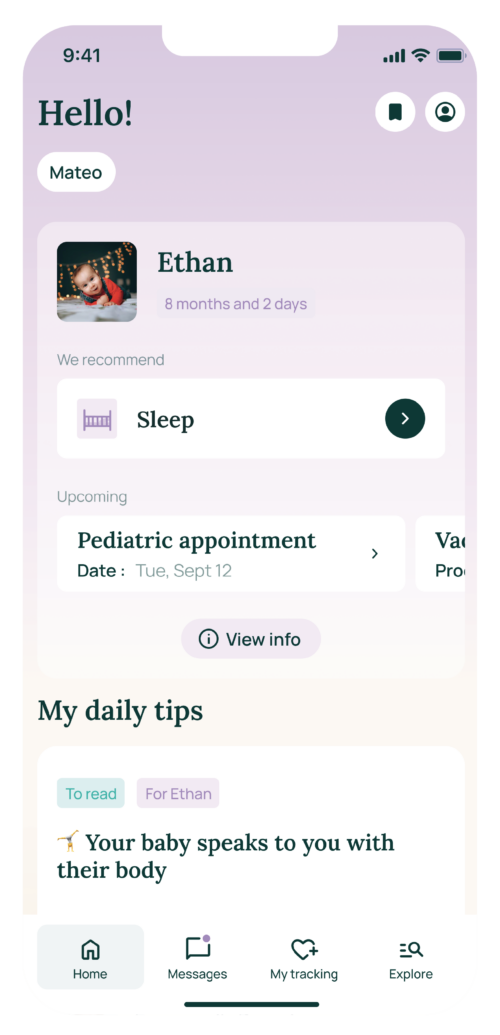
Our most viewed articles
All articles


Signs of impending labor

Labor pain: what to expect? Compare

Diarrhea before labor: how long does it last?
Access more articles, tips, and Mya by downloading the May app
Try the app for free for 14 days.


Pregnancy: the benefits of raspberry leaves

Childbirth: how can I tell if my cervix is dilated?

All About Contractions During Pregnancy

Rainbow Baby: Parents’ Testimonials

The water breaking — is it like in the movies?
D-Day: Everything about labor and delivery
Childbirth is the culmination of your 9-month journey: the long-awaited moment to meet your baby is about to arrive!
Giving birth can feel overwhelming for many women, especially for first-time moms. It’s completely normal to feel anxious. That’s why childbirth and parenting preparation classes exist.
But if you’re looking for immediate answers, you’re in the right place!
When is the baby coming?
You’re curious and excited—nothing more normal than wanting to know your baby’s due date. It helps you prepare mentally. So how is the due date calculated?
Your gynecologist or midwife will estimate it based on the first day of your last period. Then, the first-trimester ultrasound will refine this estimate by measuring your baby from head to bottom. Keep in mind, your baby might not be born exactly on that date—it could be a few days before or after.
I feel like I’m about to give birth—should I go to the hospital?
It’s not always easy to know if labor has truly started. Losing your mucus plug doesn’t necessarily mean it’s time to go. It’s also important to tell the difference between “true” labor contractions and Braxton Hicks (false) contractions, which are common at the end of pregnancy. Trust your instincts—you’ll know when it’s the real thing.
Note: Once your water breaks, your baby is no longer in a sterile environment—so head to the hospital right away!
If you’re having strong contractions every 5 minutes for at least 2 hours, that’s a clear sign your baby is coming soon.
What happens during labor?
No doubt about it—the baby’s on the way! Time to gather your strength. There are two main ways to give birth: vaginal delivery or cesarean section. Vaginal birth is usually preferred unless there’s a medical reason to choose otherwise. A cesarean can be scheduled or done in an emergency if complications arise during labor.
Pain relief, such as an epidural, can be used if the mother wishes or if medically indicated.
Some women go beyond their due date. In that case, labor induction may be recommended to avoid risks. It can be done mechanically (balloon, breaking the water) or hormonally (prostaglandins, oxytocin), depending on how ripe the cervix is. Many French maternity hospitals don’t allow a pregnancy to go more than 5 days past due. Induction is typically done between 41 weeks + 5 days and 42 weeks.
Labor happens in three main stages:
1. Labor
It starts with strong, regular uterine contractions and the breaking of the amniotic sac. During this stage, the cervix dilates. This can happen quickly or slowly, depending on many factors: if it’s your first baby, the baby’s position, and more. Labor starts around 3 cm of dilation but delivery doesn’t happen until the cervix reaches 10 cm—full dilation. Then, the baby begins descending into the pelvis. This stage can still take several hours.
2. Delivery (Expulsion)
Unless the baby is breech, the head comes out first. Usually, the neck is against the pubic bone and the mother pushes with each contraction to help the baby out. As she pushes, the baby’s head gradually moves down and the perineum stretches. If needed, an episiotomy (a small cut) may be performed with the mother’s consent to help. Once the head is out, the midwife or doctor may guide the baby’s shoulders out. And there it is—your baby is born!
3. Afterbirth (Placenta delivery)
About 15–20 minutes after birth, the uterus contracts again to help detach and expel the placenta. The mother pushes again, and the midwife applies pressure to the top of the uterus. The placenta is then checked to ensure it’s fully intact—if not, there’s a risk of postpartum hemorrhage, and a uterine examination will be performed.
You can also learn more about what happens immediately after delivery and the return of your menstrual cycle. Being informed will help you navigate this stage with confidence—knowledge is power!
